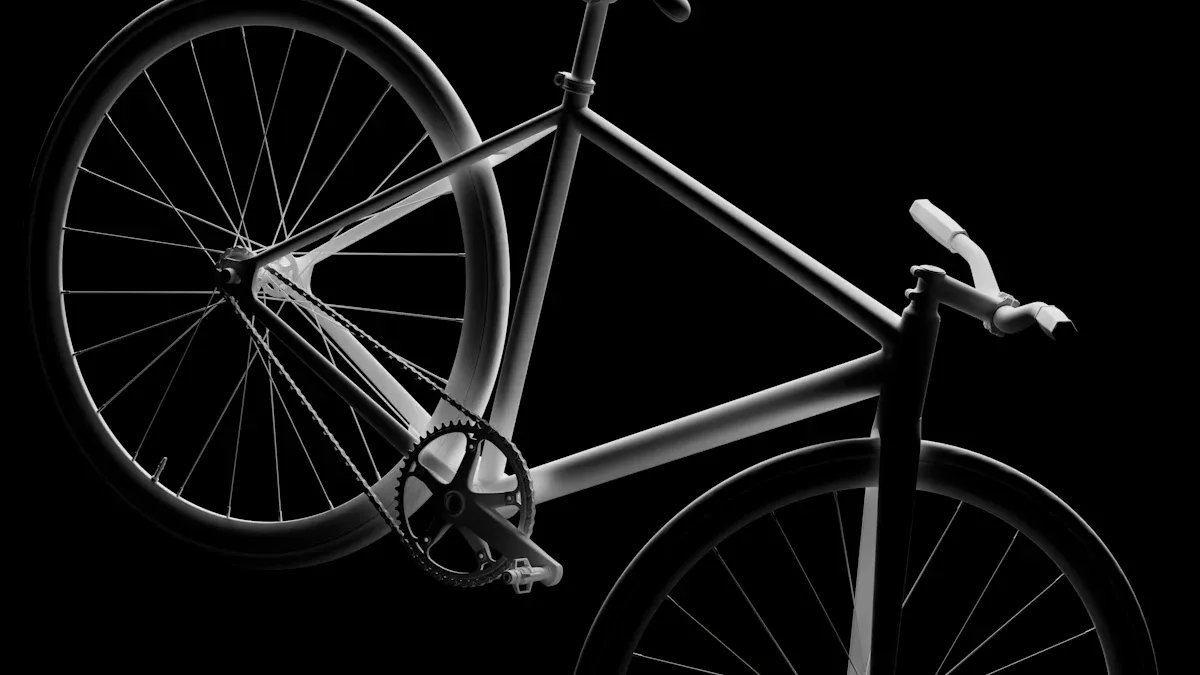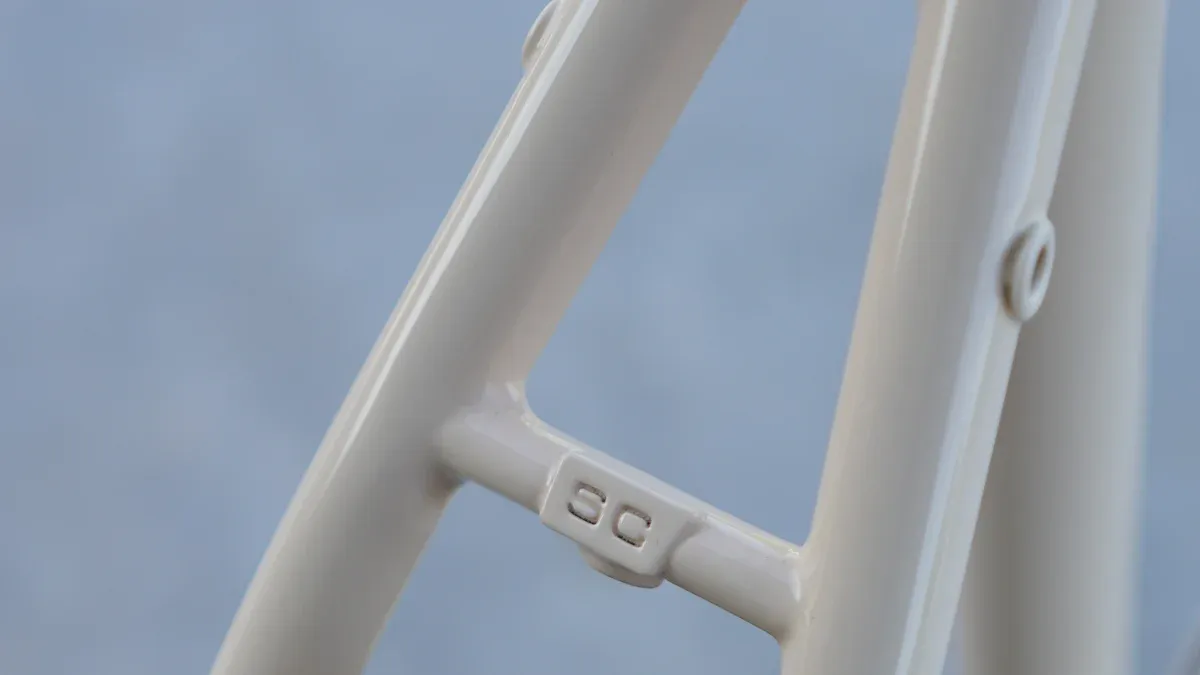
Bike frame stiffness is very important for your ride. It affects how well you use your legs to power the bike. This impacts your speed and how quickly you respond. A stiffer bike frame helps with handling. It makes it easier to turn and react to the road. But comfort is also important. Recent studies show that stiffness matters, but it should be balanced with flexibility. This balance helps make your ride enjoyable. Think about your cycling needs when choosing a stiff bike frame. The right choice can really improve your performance and fun on the road.
Key Takeaways
Bike frame stiffness is very important for power transfer. A stiffer frame sends more energy to the wheels. This helps you go faster.
Different types of stiffness are important. Lateral stiffness helps with speed. Torsional stiffness improves handling. Vertical stiffness makes rides more comfortable.
Choosing the right frame depends on how you ride. Think about your riding goals, weight, and comfort needs when picking stiffness.
The material and design affect stiffness. Carbon fiber is very stiff but light. Aluminum and steel have their own advantages.
Finding the right balance is important. A good bike frame should have stiffness for performance. It should also have enough flexibility for comfort on long rides.
Understanding Bike Frame Stiffness

Definition of Stiffness
Bike frame stiffness is how well a bike frame keeps its shape when you push on it. In simple terms, stiffness means how well a part, like a bike frame, holds its form under pressure. When you pedal, your legs push down. This force travels through the bike frame. A stiffer frame bends less. This lets more of your energy go straight to the wheels. This is very important for riders who want to go fast and use their power well.
Types of Stiffness
Knowing the different types of stiffness helps you pick the right bike frame. Here are the main types for bike frames:
Lateral Stiffness: This shows how well the frame stops side-to-side movement. More lateral stiffness helps power transfer when pedaling. This leads to better speed and control.
Torsional Stiffness: This type is about how well the frame stops twisting. Good torsional stiffness keeps the wheels aligned when turning. This gives you better control and quick reactions.
Vertical Stiffness: This is about balancing stiffness. It stops too much bouncing but allows some bending to soak up bumps. It depends on the frame design and how heavy the rider is.
The link between bending and load shows what bike frame stiffness means. A stiffer frame fights against forces when you pedal and turn better. This means more power goes from you to the bike, reducing energy loss from frame bending.
Manufacturers usually check bike frame stiffness in their labs. They put weight on the bottom bracket to mimic the forces you use when pedaling. This test shows how much the bottom bracket area bends under these conditions. Common tests include putting weight on certain spots on the frame and fork to see how much they bend. A stiffer part of the frame bends less, while a softer part bends more.
Here are some important stiffness measurements:
Head tube stiffness = precise handling
Chainstay stiffness = pedaling efficiency
Seatpost compliance = riding comfort
Knowing these things can help you choose a bike frame that fits your performance needs.
Stiffness Impact on Performance

Power Transfer Efficiency
When you pedal, your energy moves through the bike frame to the wheels. A stiffer frame is very important for this. It does not bend much under pressure. This means less of your power is wasted. For example, if a carbon frame bends 2 inches with a 400-watt load, some power is lost. But a frame that only bends 1 inch sends more power to the wheels. This helps you go faster. This efficiency is very important for competitive cyclists. They need every bit of power to do their best.
Manufacturers often highlight stiffness as a key part of power transfer.
Engineers must balance stiffness with weight and comfort for better performance.
Higher lateral stiffness is important because it reduces side-to-side movement. This stiffness helps the force you create go to the rear wheel. It affects how fast your bike can accelerate. Stiffer bike frames turn pedaling force into speed better, which improves acceleration.
Handling and Responsiveness
Stiffness also greatly affects how your bike handles. Torsional stiffness is important because it affects how the frame twists. This twisting can change wheel alignment and bike handling, especially when turning fast. If the frame is not stiff enough, it can misalign, making you correct it often.
More stiffness in the bike frame improves feedback and response when turning.
A stiffer frame helps with precise handling, making it easier to turn.
Riders feel a lighter and more direct cornering, which reduces sluggishness.
Finding the right mix of lateral and torsional stiffness is very important. Too much stiffness can make the bike feel ‘dead.’ Too little can make it feel ‘noodly.’ You want a frame that gives a smooth and responsive ride while still being comfortable.
Comfort During Rides
While stiffness helps performance, it can also affect your comfort on long rides. Stiffer frames can improve performance but might cause discomfort from road vibrations. Lower vertical stiffness can absorb bumps, giving a smoother ride. A good frame design allows for some bending, which helps comfort and performance.
The link between bike frame stiffness and rider comfort is important, especially on long rides.
Stiffer frames can boost performance but may cause discomfort from road vibrations.
A good balance of stiffness and flexibility is needed for a fun ride.
In the end, you should think about your riding style and what you like when picking a bike frame. A stiffer frame might help your cycling performance, but it could also make long rides uncomfortable. Finding the right balance between stiffness and comfort is key for a great cycling experience.
Factors Influencing a Stiffer Bike Frame
Material Choices
The material you pick for your bike frame is very important for its stiffness. Different materials have different stiffness and weight. Here’s a look at common bike frame materials:
Material | Stiffness Comparison |
|---|---|
Aluminum | |
Titanium | Half as stiff as steel |
Carbon Fiber | Very high stiffness/weight ratio |
Carbon fiber is special because it has a high stiffness-to-weight ratio. This means you get a stiff frame without adding much weight. Steel is strong and has high vertical stiffness, but it is heavier. Aluminum is a good choice because it is stiffer than steel and still light.
Design and Geometry
The design and shape of a bike frame also affect its stiffness. Here are some important things to think about:
Different tube shapes can make stiffness better in certain ways.
Bigger tube cross-sections increase stiffness while keeping weight down.
Smart arrangements of carbon fiber improve stiffness in key spots.
Tim Hartung, a design engineer at Trek Bicycles, says that the choice of materials helps makers get specific bike-handling features. He explains that carbon materials let designers control stiffness using different design parts like lay-up patterns and tube shapes.
Manufacturing Techniques
How bike frames are made also affects their stiffness. New methods help control materials and processes better. For example:
New carbon frames made with monocoque construction can have many different properties, including stiffness and strength, based on the layup process used.
Hydroforming is another method that boosts stiffness. It helps create light frame designs with strong, smooth joints. This method adds to overall strength and stiffness, which is very important for serious riders.
By knowing these factors, you can make smart choices about your bike frame. Whether you want a stiff frame for better performance or a mix of stiffness and comfort, understanding materials, design, and manufacturing will help you decide.
Choosing the Right Bike Stiffness for You
Assessing Your Cycling Style
To choose the right bike stiffness, start by looking at your cycling style. Think about these things:
Riding Goals: Are you racing, commuting, or just riding for fun? Your goals will affect the stiffness you need.
Rider Weight: Heavier riders usually need stiffer frames for better power transfer. If you weigh more, a stiffer bike helps you use your energy better.
Comfort Needs: If you often feel sore on long rides, a more flexible frame might be better. This flexibility can soak up road bumps and improve your ride.
Professional bike fitters say it’s important to know your riding style. They use tests like deflection tests and strain gauges to see how much a frame bends when you push on it. These tests help find the best frame stiffness for you.
Balancing Comfort and Performance
Finding the right mix of comfort and performance is very important. Here are some key things to think about:
Factor | Description |
|---|---|
Head Tube Angle | Affects how quickly you steer; steeper angles are better for racing, while slacker angles give stability. |
Seat Tube Angle | Changes your position over the pedals; a steeper angle helps power, while a slacker angle makes it more comfy. |
Wheelbase | A longer wheelbase gives stability; a shorter wheelbase makes the bike easier to handle. |
Stack & Reach | Stack affects how upright you sit (higher = more comfort), while reach affects how stretched out you are (longer = more aggressive). |
Frame Material | Balances weight, stiffness, comfort, and cost; aluminum and carbon are good for performance, while steel is comfy. |
Knowing these factors helps you make smart choices about your bike frame. You want a setup that lets you transfer energy well while still being comfy on long rides.
Understanding bike frame stiffness is very important for improving your cycling experience. Here are some main points to think about:
Lateral stiffness helps with power transfer and reduces bending when pedaling.
Torsional stiffness is key for bike handling, especially when turning, as it keeps the wheels aligned.
Vertical stiffness needs to balance strength to stop bouncing while soaking up bumps in the road.
As technology gets better, you will have more choices to customize your bike frame. This lets you adjust stiffness and shape to fit your needs. Think about how you ride and what you like to pick the best frame that boosts both performance and comfort.
FAQ
What is the benefit of a stiffer bike frame?
A stiffer bike frame improves power transfer. When you pedal, more energy goes directly to the wheels. This helps you accelerate faster and maintain higher speeds.
How does frame stiffness affect comfort?
While a stiffer bike can enhance performance, it may lead to discomfort on rough roads. A balance between stiffness and flexibility is essential for a comfortable ride.
Should I choose a stiffer bike for racing?
Yes, a stiffer bike is often better for racing. It allows for efficient power transfer and quick handling, which are crucial for competitive cycling.
Can a stiffer bike frame handle rough terrain?
A stiffer bike frame may struggle on rough terrain. It can transmit more vibrations to the rider. Consider a frame with some vertical compliance for better comfort on bumpy roads.
How do I know if I need a stiffer bike?
Assess your riding style and goals. If you prioritize speed and power, a stiffer bike may suit you. If comfort is more important, consider a frame with some flexibility.
See Also
Understanding Track Bike Frame Materials And Their Importance
How To Choose The Perfect Bike Frame For You
Comparing Enduro Bike Frame Materials For Durability And Strength
